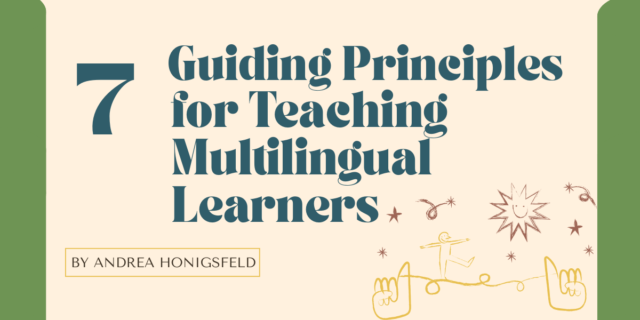
This is the first part of the "Social-Emotional Support for Adolescent Multilingual Learners" blog series, adapted from Andrea Honigsfeld's forthcoming Growing Language and Literacy, Grades 6-12.
***
When you welcome newcomer multilingual learners (MLs), put yourself in their shoes and consider—through the eyes of each person—what their first impressions might be. What do they see and hear? What do they notice and wonder about? Keep in mind that if they don’t understand your verbal input, they will certainly be more responsive to nonverbal cues they can “read”: your body language, facial impressions, smiles and frowns, gestures, tone of voice, and so on.
Let’s flip the coin: What are your first impressions of your newcomers? What do you first notice about your secondary MLs at the starting level? How about their peers—what do they see when a newcomer walks through the doors of your classroom? Tung’s (2013) caution to us is as apt now as it was a decade ago: let’s not view multilingual “education as a problem, dilemma, achievement gap, or crisis”; instead, she urges us to “embrace ELLs as the very community members who, when well educated, will be the bicultural, bilingual leaders who improve our city neighborhoods and help us participate effectively in the global economy” (4).
As newcomers, they need to orient themselves to so many new things! To thrive, they need to develop self-confidence in a new school, neighborhood, state, or country. And let’s not forget: they have to do all this in a new language! It is expected that many of your newcomers will experience some level of anxiety and fear, especially if their mental, physical, and social needs are shaped by dislocation and trauma and their academic self-concepts are shaped by limited or interrupted prior education.

It’s impossible to overstate the importance of relationships. Kristen McInerney’s (2023) study on the predictors and experiences newcomer multilingual adolescents have in a high school further validates it. She found that the close to five hundred students they surveyed utilized “an intricate web of support from peers, staff, and families that contributed to their sense of belonging so that school felt like a second family or second home” (22). They also appreciate learning from classmates who come from other cultures and speak other languages as they establish common interests and common languages (English or another lingua franca with them).
***
Listen to Andrea in conversation with Pam Schwallier on the Heinemann Podcast.

Growing Language and Literacy: Strategies for Secondary Multilingual Learners, Grades 6-12 released on April 16th.

Dr. Andrea Honigsfeld is TESOL professor at Molloy University , Rockville Centre, NY. Before entering the field of teacher education, she was an English as a Foreign Language teacher in Hungary (grades 5-8 and adult), an English as a Second Language teacher in New York City (grades K-3 and adult), and taught Hungarian at New York University. A Fulbright Scholar and sought after national presenter, Andrea is the coauthor or coeditor of 27 books on education and numerous chapters and research articles related to the needs of diverse learners. Andrea is coauthor of the Core Instructional Routines books with Judy Dodge. Visit Andrea at www.andreahonigsfeld.com.


